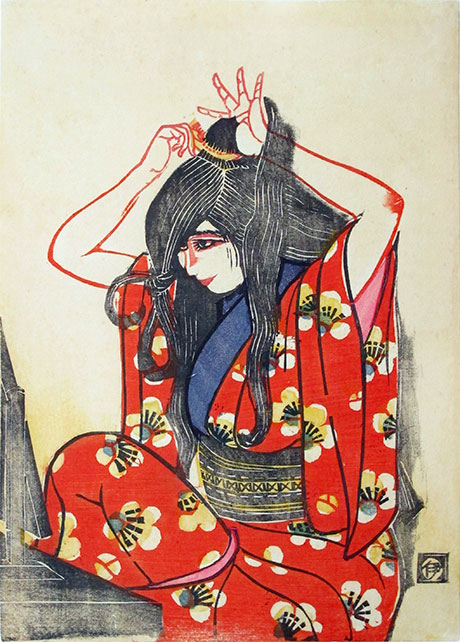 Nakagawa Isaku ( 1899-2000) was born in Kyoto and graduated from the Kyoto Shiritsu Bijutsu Kôgei Gakkô (Kyoto City School of Fine Arts and Crafts) in 1918 (studying with Kikuchi Keigetsu, 1879-1955) and the Kyoyo Shiritsu Kaiga Senmon Gakkô (Kyoto City Specialist School of Painting) in 1921. His prints of women issued in the 1930s are admired for the realism of their gestures and the detailed and accurately rendered textile patterns. He was also fond of depicting images of fish (see NKG01), as well as landscapes and portraits. Overall, Nakagawa's prints have survived in very few impressions, suggesting his editions were rather small. Nakagawa Isaku ( 1899-2000) was born in Kyoto and graduated from the Kyoto Shiritsu Bijutsu Kôgei Gakkô (Kyoto City School of Fine Arts and Crafts) in 1918 (studying with Kikuchi Keigetsu, 1879-1955) and the Kyoyo Shiritsu Kaiga Senmon Gakkô (Kyoto City Specialist School of Painting) in 1921. His prints of women issued in the 1930s are admired for the realism of their gestures and the detailed and accurately rendered textile patterns. He was also fond of depicting images of fish (see NKG01), as well as landscapes and portraits. Overall, Nakagawa's prints have survived in very few impressions, suggesting his editions were rather small.
Nakagawa was involved in the founding of the Kyoto Sôsaku-hanga Kyôkai (Kyoto Creative Print Society: 京都創作版画協会) in 1929, along with various other artists, and he was a member of Nihon Hanga Kyôkai (Japan Print Association, founded in 1931) from 1932. He contributed to dôjin zasshi (coterie art magazines: 同人雑誌) such as Han geijutsu ("Print Art": 版芸術) and joined three other artists (Benji Asada, Takeji Asano, and Tokuriki Tomikichirô) in a twelve-print set issued sometime in the early 1930s (for which the artists designed three prints each). Earlier, in the mid-1920s, these same four artists had formed the so-called Yonin Sôsaku Hanga Hanpukai (Four-Men Creative Print Distribution Club: 四人創作版画頒布会) in Kyoto.
Aside from printmaking, from around the mid 1920s, the multi-faceted Nakagawa made his living as an antique dealer and became president of the Oriental Antique Art Study Group in 1936. That same year, he produced a charming work titled Kamiyui (Hairdressing: 髪結) in aiban format (335 x 220 mm); see image above right.
He was also involved with collecting folk crafts and making pottery. In 1928 he went to Okinawa for the first time together with Yanagi Sôetsu (柳宗悦 1889-1961), co-founder of the Nihon Mingei Kyôkai (Japan Folk Art Society: 日本民芸協会 1931) in collaboration with the distinguished potters Kawai Kanjirô (河井寬次郎 1890-1966) and Hamada Shôji (濱田庄司1894-1978). He also produced two books on the fabrics of Okinawa: Nanpô kafu (1941) and Ryûkyû orimono (1952), the former illustrated with his color woodblock prints.
Starting in 1960, Nakagawa was a visiting professor at the San Francisco Art Institute, where he lectured on Asian painting and modern prints. By 1964, in the same city, he was a guest lecturer at the Rudolf Schaeffer School of Design. During this time, Nakagawa also lectured on Asian painting at several state universities and other educational institutions in California. In 1964 he was awarded a key to the city by the mayor of San Francisco for his educational contributions and for having held exhibitions of his art works (there were ten in all during his nearly twelve years in the U.S.).
In his very long life, Nakagawa contributed to numerous international exhibitions. He enjoyed traveling throughout the Americas and Mexico, the latter for the first time in 1967. Then, in 1972, he moved to Chinaba, Okinawa, where he remained for the rest of his life, working and exhibiting until his death in 2000.
Prints by Nakagawa Isaku are in the collections of the Harvard Art Museums; Honolulu Museum of Art; Museum of Fine Arts, Boston; and National Museum of Modern Art, Tokyo (東京国立近代美術館).
The text provided here is based in large part on John Fiorillo's web page:
https://viewingjapaneseprints.net/texts/sosaku_hanga/nakagawa_isaku.html |